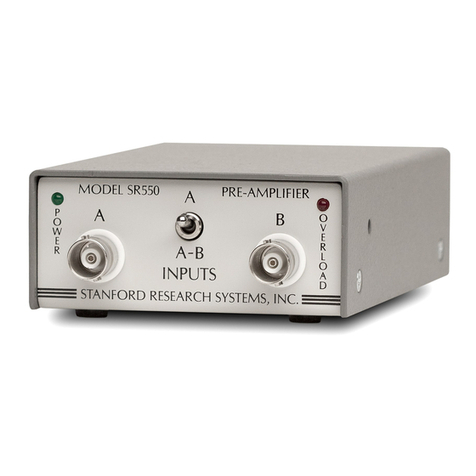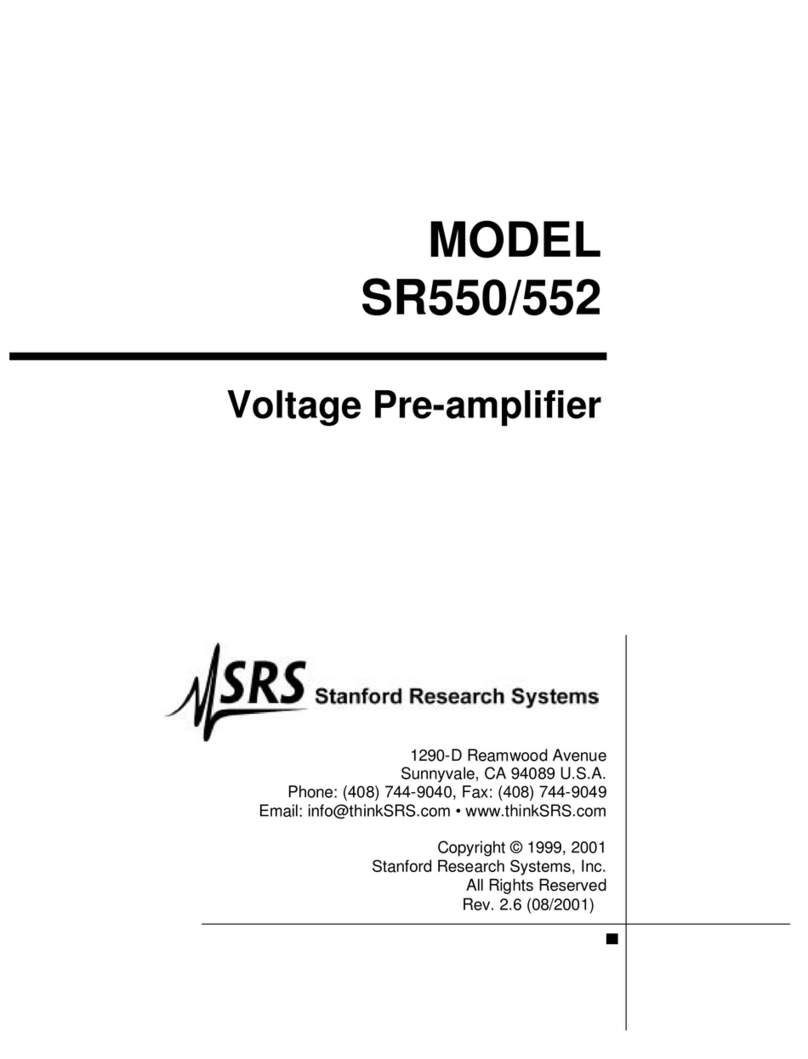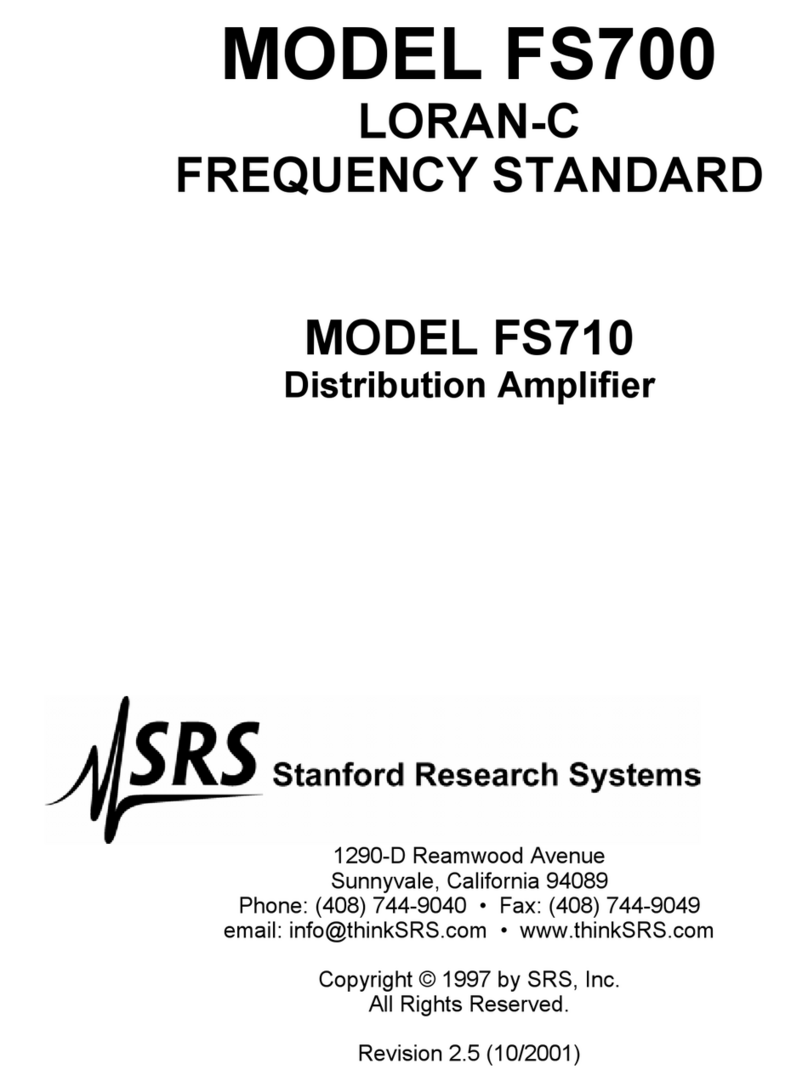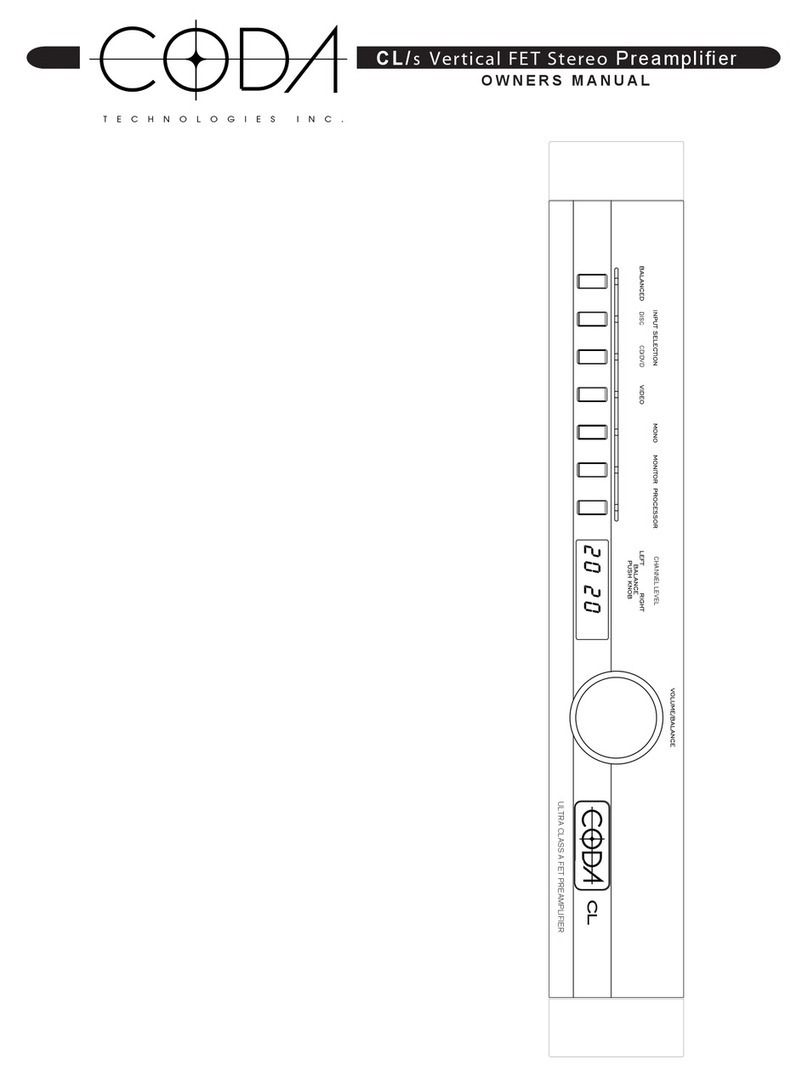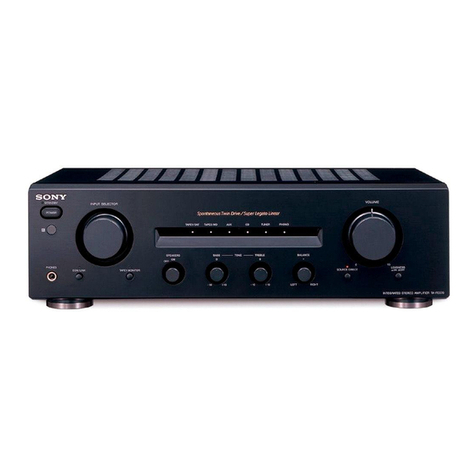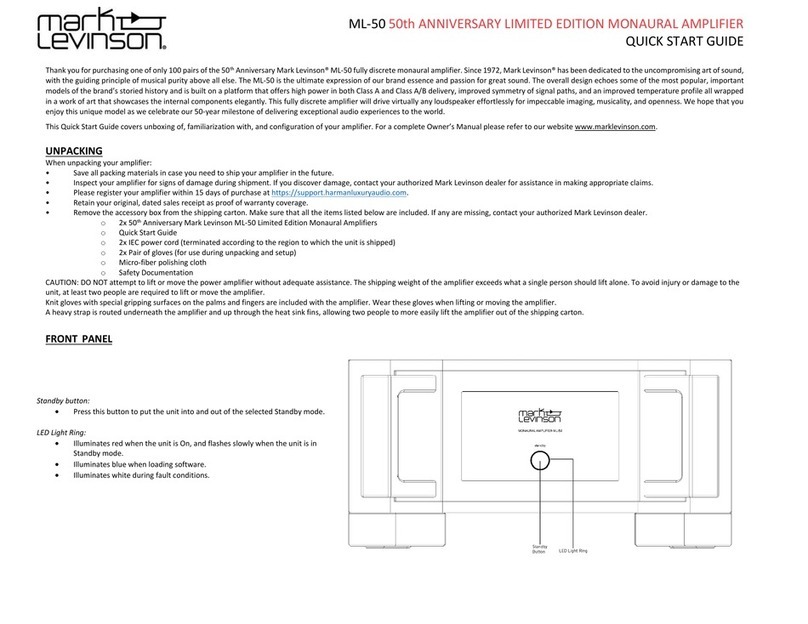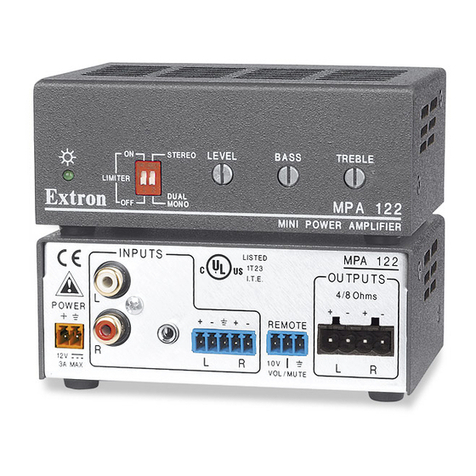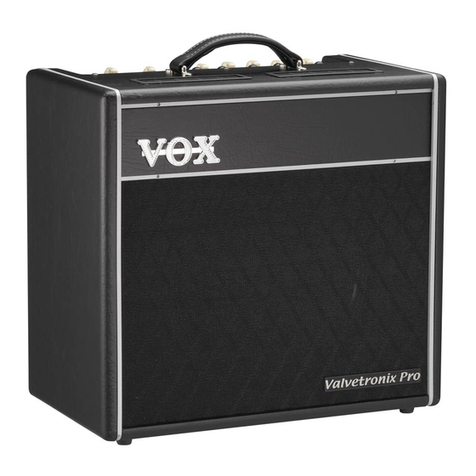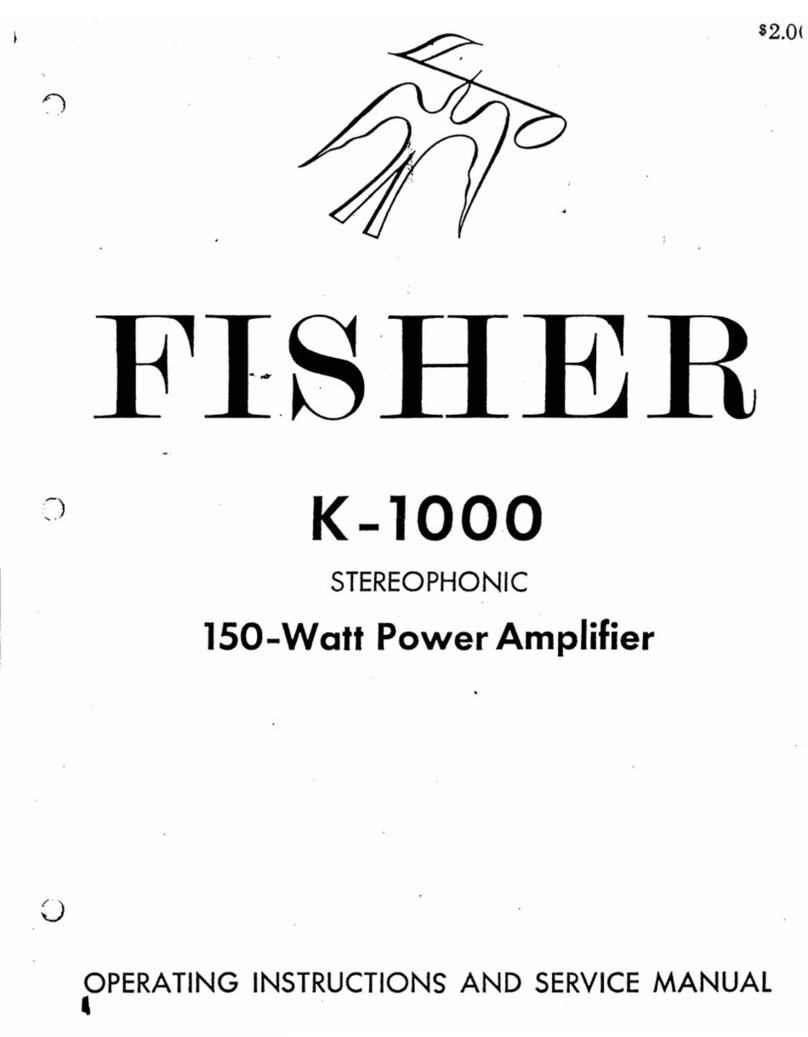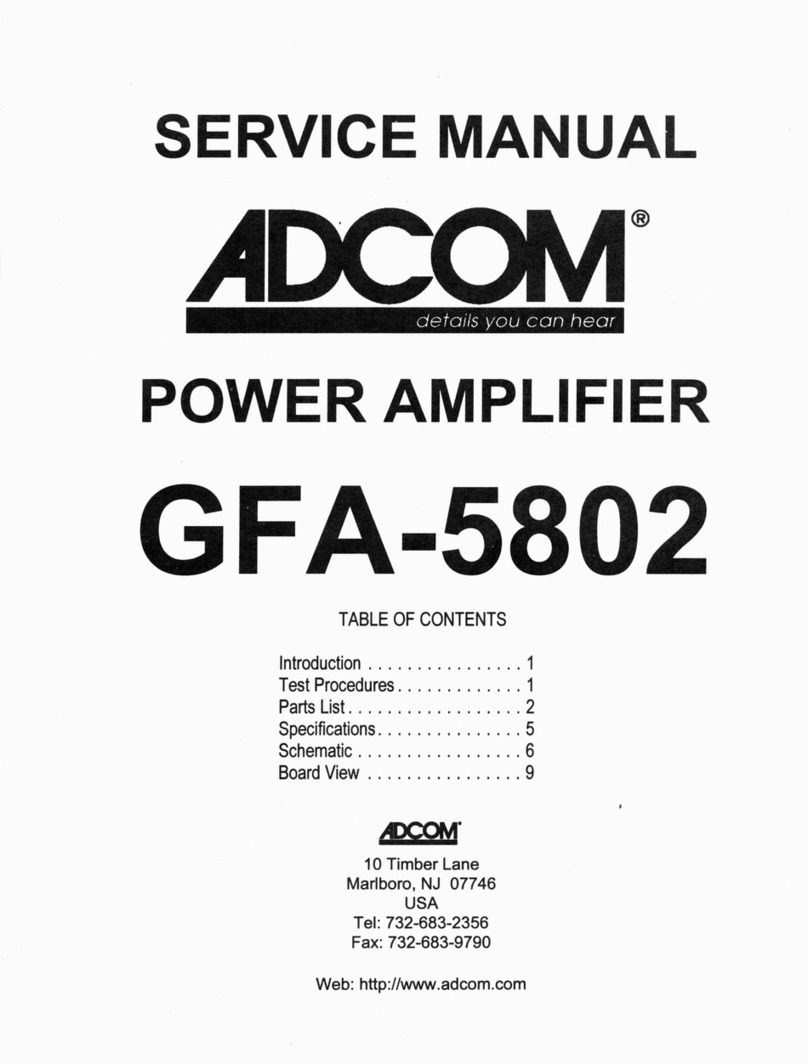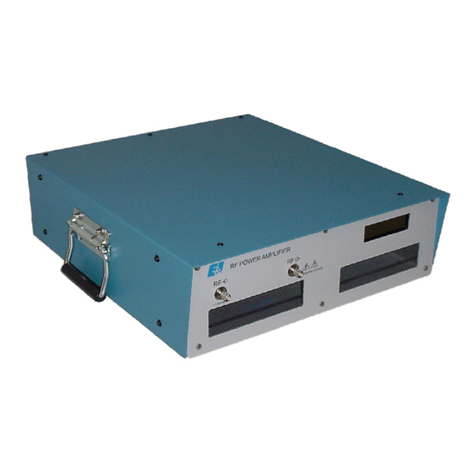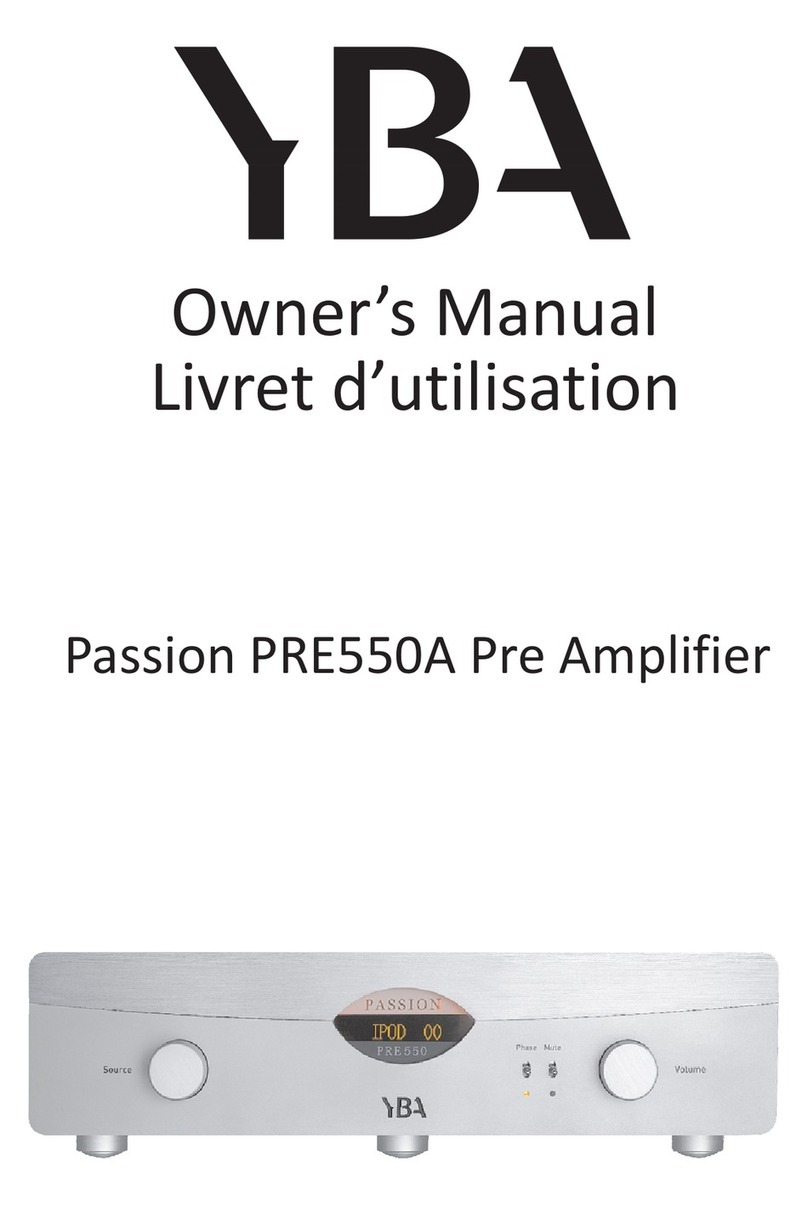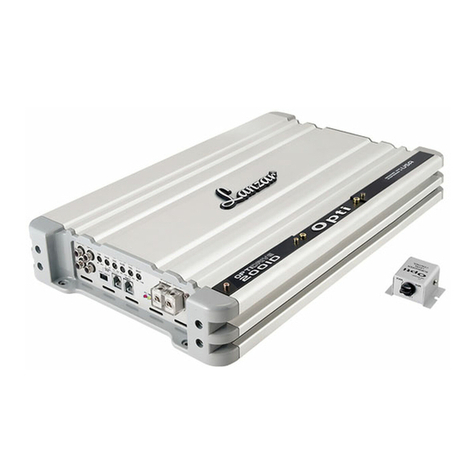SRS Labs SIM980 Operation manual

Operation and Service Manual
Analog Summing Amplifier
SIM980
Stanford Research Systems
Revision 1.9 •August 28, 2006

Certification
Stanford Research Systems certifies that this product met its published specifications at the time
of shipment.
Warranty
This Stanford Research Systems product is warranted against defects in materials and workman-
ship for a period of one (1) year from the date of shipment.
Service
For warranty service or repair, this product must be returned to a Stanford Research Systems
authorized service facility. Contact Stanford Research Systems or an authorized representative
before returning this product for repair.
Information in this document is subject to change without notice.
Copyright c
Stanford Research Systems, Inc., 2005, 2006. All rights reserved.
Stanford Research Systems, Inc.
1290–D Reamwood Avenue
Sunnyvale, CA 94089 USA
Phone: (408) 744-9040 •Fax: (408) 744-9049
Printed in U.S.A. Document number 9-01591-903
SIM980 Analog Summing Amplifier

Contents
General Information iii
Symbols ............................. iv
Notation ............................. v
Specifications .......................... vi
1 Getting Started 1 – 1
1.1 Introduction to the Instrument . . . . . . . . . . . . . 1 – 2
1.2 Front-Panel Operation . . . . . . . . . . . . . . . . . . 1 – 2
1.3 SIMInterface........................ 1–4
2 Remote Operation 2 – 1
2.1 Index of Common Commands . . . . . . . . . . . . . . 2 – 2
2.2 Alphabetic List of Commands . . . . . . . . . . . . . . 2 – 4
2.3 Introduction ........................ 2–6
2.4 Commands......................... 2–6
2.5 StatusModel........................ 2–17
3 Performance Tests 3 – 1
3.1 Introduction ........................ 3–2
3.2 Tools and preparation . . . . . . . . . . . . . . . . . . 3 – 2
3.3 Precalibration Values . . . . . . . . . . . . . . . . . . . 3 – 2
3.4 Calibration......................... 3–4
3.5 Other tests and adjustments . . . . . . . . . . . . . . . 3 – 6
3.6 SIM980 Performance Test Record . . . . . . . . . . . . 3 – 7
4 Circuitry 4 – 1
4.1 Circuit Descriptions . . . . . . . . . . . . . . . . . . . . 4 – 2
4.2 PartsLists ......................... 4–4
4.3 Schematic Diagrams . . . . . . . . . . . . . . . . . . . 4 – 5
i

ii Contents
SIM980 Analog Summing Amplifier

General Information
The SIM980 Summing Amplifier, part of Stanford Research Sysetems’
Small Instrumentation Modules family, is a four-input, unity-gain
amplifier for combining multiple analog signals from DC to 1 MHz.
Service
Do not install substitute parts or perform any unauthorized modifi-
cations to this instrument.
The SIM980 is a single-wide module designed to be used inside the
SIM900 Mainframe. Do not turn on the power until the module is
completely inserted into the mainframe and locked in place.
iii

iv General Information
Symbols you may Find on SRS Products
Symbol Description
Alternating current
Caution - risk of electric shock
Frame or chassis terminal
Caution - refer to accompanying documents
Earth (ground) terminal
Battery
Fuse
On (supply)
Off (supply)
SIM980 Analog Summing Amplifier

General Information v
Notation
The following notation will be used throughout this manual.
A warning means that injury or death is possible if the instructions
WARNING are not obeyed.
A caution means that damage to the instrument or other equipment
CAUTION is possible.
Typesetting conventions used in this manual are:
•Front-panel buttons are set as [Button];
[Adjust ] is shorthand for “[Adjust ] & [Adjust ]”.
•Front-panel indicators are set as Overload.
•Remote command names are set as *IDN?.
•Literal text other than command names is set as OFF.
Remote command examples will all be set in monospaced font. In
these examples, data sent by the host computer to the SIM980 are set
as straight teletype font, while responses received by the host
computer from the SIM980 are set as slanted teletype font.
SIM980 Analog Summing Amplifier

vi General Information
Specifications
Performance Characteristics
Number of inputs 4
Function Inverting, non-inverting, or off
Gain 1×
Input impedance 1 MΩ
Bandwidth DC to 1 MHz
Output voltage noise 30 nV/√Hz@ 1 kHz, max.
Crosstalk −80 dB @ 1 kHz
Offset voltage ±100 µV (after 5 min. warm up)
Input range ±10 V before overload
Output range ±10 V before overload
Input slew rate 40 V/µs
Total Harmonic Distortion 0.01% (−80 dB) max. @ 1 kHz
Output slew rate 75 V/µs
Operating temperature 0 ◦C to 40 ◦C, non-condensing
Power +5 V (100 mA)
±15 V (300 mA)
General Characteristics
Interface Serial (RS-232) through SIM interface
Connectors BNC (5 front, 1 rear)
DB–15 (male) SIM interface
Weight 1.5 lbs
Dimensions 1.500 W×3.600 H×7.000 D
SIM980 Analog Summing Amplifier

1 Getting Started
This chapter gives you the necessary information to get started
quickly with the SIM980 Summing Amplifier.
In This Chapter
1.1 Introduction to the Instrument . . . . . . . . . . . . 1 – 2
1.1.1 Overview .................... 1–2
1.1.2 Power-on State . . . . . . . . . . . . . . . . . 1 – 2
1.2 Front-Panel Operation . . . . . . . . . . . . . . . . . 1 – 2
1.2.1 Inputs ...................... 1–3
1.2.2 Output...................... 1–4
1.3 SIMInterface ...................... 1–4
1.3.1 SIM interface connector . . . . . . . . . . . . 1 – 4
1.3.2 Direct interfacing . . . . . . . . . . . . . . . . 1 – 4
1–1

1–2 Getting Started
1.1 Introduction to the Instrument
The SIM980 Summing Amplifier is a four-input, unity-gain amplifier
for combining multiple analog signals from DC to 1 MHz.
1.1.1 Overview
The basic function of the SIM980 is to add or subtract up to four
analog signals. Each input channel can be separately configured for
inverting or non-inverting operation, or switched off. Each input is
1 MΩand DC-coupled, and accepts signals between ±10 V.
1.1.2 Power-on State
The SIM980 stores its operation state (input channel configuration)
in non-volatile memory. At power-on, the SIM980 will return to its
previous configuration after a brief system check and initialization.
1.2 Front-Panel Operation
The front panel of the SIM980 (see Figure 1.1) provides a simple
operator interface.
Figure 1.1: The SIM980 front and rear panels.
SIM980 Analog Summing Amplifier

1.2 Front-Panel Operation 1–3
1.2.1 Inputs
Each of the four input channels of the SIM980 has a front-panel block
consisting of the BNC input connector, a control button, and several
LED indicators.
1.2.1.1 Polarity toggle
Each input can be switched between inverting or non-inverting po-
larity by briefly pressing that channel’s control button. When invert-
ing, the −LED is illuminated; when non-inverting, +is lit. Note
that the polarity is always displayed, independent of whether that
channel is on or off.
1.2.1.2 On/Off toggle
Each input can independently be turned on or offby holding that
channel’s control button for ∼1.5 seconds. When on, the channel is
either added to or subtracted from the output (depending on polarity,
section 1.2.1.1). When off, it does not contribute to the output signal
at all. The OFF LED is lit to indicate when a channel is off.
Unused channels should be turned offrather than simply left un-
connected, as the Johnson noise of the open 1 MΩinput resistor will
dominate the output noise of the SIM980.
1.2.1.3 Offset autocalibration
The SIM980 uses an active input offset correction to trim all input
circuitry as well as the summing circuitry of DC offsets. The user
can initiate an autocalibration cycle by disconnecting all inputs and
outputs from the SIM980, and pressing and holding any of the con-
trol buttons for ∼5 seconds. The entire process takes approximately
1 minute, and is completed when the relays have stopped “clicking”
for at least 10 seconds.
Note that it is important that all inputs be open (or, preferably, shorted
to ground) before initiating an offset autocalibration cycle. If any
input channel is above ∼500 µV amplitude, the SIM980 will reject the
autocalibration request.
1.2.1.4 Input Overload
Each of the four input channels of the SIM980 has an overload de-
tection circuit. The input is considered overloaded when the signal
magnitude exceeds ±10 V. This is indicated by the red OVLD LED at
the top of each front-panel block.
SIM980 Analog Summing Amplifier

1–4 Getting Started
1.2.2 Output
The resulting sum of the enabled input channels appears at the output
BNC connectors on the front and rear panels. Each output connection
is through a 50 Ωresistor. For normal operation, the user should not
need to terminate the output. If a 50 Ωtermination is applied, note
that the output signal will be divided in half.
If the output signal exceeds ±10 V, the output overload detection is
activated. This is indicated by the red OVLD near the top of the
“OUTPUT” block on the front panel.
1.3 SIM Interface
The primary connection to the SIM980 Summing Amplifier is the
rear-panel DB–15 SIM interface connector. Typically, the SIM980 is
mated to a SIM900 Mainframe via this connection, either through
one of the internal Mainframe slots, or the remote cable interface.
It is also possible to operate the SIM980 directly, without using the
SIM900 Mainframe. This section provides details on the interface.
The SIM980 has no internal protection against reverse polarity, missing
CAUTION supply, or overvoltage on the power supply pins. Misapplication of power
may cause circuit damage. SRS recommends using the SIM980 together
with the SIM900 Mainframe for most applications.
1.3.1 SIM interface connector
The DB–15 SIM interface connector carries all the power and commu-
nications lines to the instrument. The connector signals are specified
in Table 1.1
1.3.2 Direct interfacing
The SIM980 is intended for operation in the SIM900 Mainframe, but
users may wish to directly interface the module to their own systems
without the use of additional hardware.
The mating connector needed is a standard DB–15 receptacle, such as
Amp part # 747909-2 (or equivalent). Clean, well-regulated supply
voltages of ±15,+5 VDC must be provided, following the pin-out
specified in Table 1.1. Ground must be provided on pins 1 and 8,
with chassis ground on pin 9. The −STATUS signal may be monitored
on pin 2 for a low-going TTL-compatible output indicating a status
message.
SIM980 Analog Summing Amplifier

1.3 SIM Interface 1–5
Direction
Pin Signal Src ⇒Dest Description
1 SIGNAL GND MF ⇒SIM Ground reference for signal
2−STATUS SIM ⇒MF Status/service request (GND =asserted, +5 V=idle)
3 RTS MF ⇒SIM HW handshake (+5 V=talk; GND =stop)
4 CTS SIM ⇒MF HW handshake (+5 V=talk; GND =stop)
5−REF 10MHZ MF ⇒SIM 10 MHz reference (no connection in SIM980)
6−5 V MF ⇒SIM Power supply (no connection in SIM980)
7−15 V MF ⇒SIM Power supply
8 PS RTN MF ⇒SIM Power supply return
9 CHASSIS GND Chassis ground
10 TXD MF ⇒SIM Async data (start bit =“0”= +5 V; “1” =GND)
11 RXD SIM ⇒MF Async data (start bit =“0”= +5 V; “1” =GND)
12 +REF 10MHz MF ⇒SIM 10 MHz reference (no connection in SIM980)
13 +5 V MF ⇒SIM Power supply
14 +15 V MF ⇒SIM Power supply
15 +24 V MF ⇒SIM Power supply (no connection in SIM980)
Table 1.1: SIM Interface Connector Pin Assignments, DB-15
1.3.2.1 Direct interface cabling
If the user intends to directly wire the SIM980 independent of the
SIM900 Mainframe, communication is usually possible by directly
connecting the appropriate interface lines from the SIM980 DB–15
plug to the RS-232 serial port of a personal computer.1Connect RXD
from the SIM980 directly to RD on the PC, TXD directly to TD, and
similarly RTS→RTS and CTS→CTS. In other words, a null-modem
style cable is not needed.
To interface directly to the DB–9 male (DTE) RS-232 port typically
found on contemporary personal computers, a cable must be made
with a female DB–15 socket to mate with the SIM980, and a female
DB–9 socket to mate with the PC’s serial port. Separate leads from
the DB–15 need to go to the power supply, making what is sometimes
know as a “hydra” cable. The pin-connections are given in Table 1.2.
1.3.2.2 Serial settings
The initial serial port settings at power-on are: 9600 Baud, 8–bits, no
parity, 1 stop bit, and RTS/CTS flow control. The serial baud rate is
fixed, but the word size and parity may be changed with the FLOW
or PARI commands.
1Although the serial interface lines on the DB-15 do not satisfy the minimum
voltage levels of the RS-232 standard, they are typically compatible with desktop
personal computers
SIM980 Analog Summing Amplifier

1–6 Getting Started
DB–15/F to SIM980 Name
DB–9/F
3→ 7 RTS
4→ 8 CTS
10 → 3 TxD
11 → 2 RxD
5 Computer Ground
to P/S
7→ −15 VDC
13 → +5 VDC
14 → +15 VDC
8,9 → Ground (P/S return current)
1→ Signal Ground (separate wire to Ground)
Table 1.2: SIM980 Direct Interface Cable Pin Assignments
SIM980 Analog Summing Amplifier

2 Remote Operation
This chapter describes operating the SIM980 over the serial interface.
In This Chapter
2.1 Index of Common Commands . . . . . . . . . . . . 2 – 2
2.2 Alphabetic List of Commands . . . . . . . . . . . . 2 – 4
2.3 Introduction....................... 2–6
2.3.1 Power-on configuration . . . . . . . . . . . . 2 – 6
2.3.2 Buffers ...................... 2–6
2.3.3 Device Clear . . . . . . . . . . . . . . . . . . . 2 – 6
2.4 Commands ....................... 2–6
2.4.1 Command Syntax . . . . . . . . . . . . . . . . 2 – 7
2.4.2 Notation..................... 2–8
2.4.3 Examples .................... 2–8
2.4.4 Amplifier Commands . . . . . . . . . . . . . 2 – 9
2.4.5 Autocalibration Commands . . . . . . . . . . 2 – 10
2.4.6 Serial Communication Commands . . . . . . 2 – 11
2.4.7 Status Commands . . . . . . . . . . . . . . . 2 – 11
2.4.8 Interface Commands . . . . . . . . . . . . . . 2 – 13
2.5 StatusModel ...................... 2–17
2.5.1 Status Byte (SB) . . . . . . . . . . . . . . . . . 2 – 18
2.5.2 Service Request Enable (SRE) . . . . . . . . . 2 – 19
2.5.3 Standard Event Status (ESR) . . . . . . . . . 2 – 19
2.5.4 Standard Event Status Enable (ESE) . . . . . 2 – 19
2.5.5 Communication Error Status (CESR) . . . . . 2 – 20
2.5.6 Communication Error Status Enable (CESE) 2 – 20
2.5.7 Overload Status (OVCR) . . . . . . . . . . . . 2 – 21
2.5.8 Overload Status (OVSR) . . . . . . . . . . . . 2 – 21
2.5.9 Overload Status Enable (OVSE) . . . . . . . . 2 – 21
2–1

2–2 Remote Operation
2.1 Index of Common Commands
symbol definition
i,jIntegers
zLiteral token
(?) Required for queries; illegal for set commands
var parameter always required
{var}required parameter for set commands; illegal for queries
[var] optional parameter for both set and query forms
Amplifier
CHAN(?) i{,j}2 – 9 Channel Control
READ? [i]2 – 9 Read Offset Voltage
Autocalibration
ARMC(?) [z]2 – 10 Arm Autocalibration
ACAL 2 – 10 Perform Offset Autocalibration
OFST(?) i{,j}2 – 10 Offset Value
Serial Communications
FLOW(?) {z}2 – 11 Flow Control
PARI(?) {z}2 – 11 Parity
Status
*STB? [i]2 – 11 Status Byte
*SRE(?) [i,]{j}2 – 11 Service Request Enable
*CLS 2 – 12 Clear Status
*ESR? [i]2 – 12 Standard Event Status
*ESE(?) [i,]{j}2 – 12 Standard Event Status Enable
CESR? [i]2 – 12 Comm Error Status
CESE(?) [i,]{j}2 – 12 Comm Error Status Enable
OVCR? [i]2 – 12 Overload Condition
OVSR? [i]2 – 13 Overload Status
OVSE(?) [i,]{j}2 – 13 Overload Status Enable
PSTA(?) {z}2 – 13 Pulse −STATUS Mode
Interface
*RST 2 – 13 Reset
*IDN? 2 – 14 Identify
*OPC(?) 2 – 14 Operation Complete
CONS(?) {z}2 – 14 Console Mode
LEXE? 2 – 14 Execution Error
LCME? 2 – 15 Command Error
SIM980 Analog Summing Amplifier

2.1 Index of Common Commands 2–3
LBTN? 2 – 15 Button
TOKN(?) {z}2 – 15 Token Mode
TERM(?) {z}2 – 16 Response Termination
SIM980 Analog Summing Amplifier

2–4 Remote Operation
2.2 Alphabetic List of Commands
?
*CLS 2 – 12 Clear Status
*ESE(?) [i,]{j}2 – 12 Standard Event Status Enable
*ESR? [i]2 – 12 Standard Event Status
*IDN? 2 – 14 Identify
*OPC(?) 2 – 14 Operation Complete
*RST 2 – 13 Reset
*SRE(?) [i,]{j}2 – 11 Service Request Enable
*STB? [i]2 – 11 Status Byte
A
ACAL 2 – 10 Perform Offset Autocalibration
ARMC(?) [z]2 – 10 Arm Autocalibration
C
CESE(?) [i,]{j}2 – 12 Comm Error Status Enable
CESR? [i]2 – 12 Comm Error Status
CHAN(?) i{,j}2 – 9 Channel Control
CONS(?) {z}2 – 14 Console Mode
F
FLOW(?) {z}2 – 11 Flow Control
L
LBTN? 2 – 15 Button
LCME? 2 – 15 Command Error
LEXE? 2 – 14 Execution Error
O
OFST(?) i{,j}2 – 10 Offset Value
OVCR? [i]2 – 12 Overload Condition
OVSE(?) [i,]{j}2 – 13 Overload Status Enable
OVSR? [i]2 – 13 Overload Status
P
PARI(?) {z}2 – 11 Parity
PSTA(?) {z}2 – 13 Pulse −STATUS Mode
R
READ? [i]2 – 9 Read Offset Voltage
SIM980 Analog Summing Amplifier

2.2 Alphabetic List of Commands 2–5
T
TERM(?) {z}2 – 16 Response Termination
TOKN(?) {z}2 – 15 Token Mode
SIM980 Analog Summing Amplifier

2–6 Remote Operation
2.3 Introduction
Remote operation of the SIM980 is through a simple command lan-
guage documented in this chapter. Both set and query forms of
most commands are supported, allowing the user complete control
of the summing amplifier from a remote computer, either through
the SIM900 Mainframe or directly via RS-232 (see Section 1.3.2.1).
See Table 1.1 for specification of the DB–15 SIM interface connector.
2.3.1 Power-on configuration
The settings for the remote interface are 9600 baud with no parity
and hardware flow control, and local echo disabled (CONS OFF).
Most of the SIM980 instrument settings are stored in non-volatile
memory, and at power-on the instrument returns to the state it was
last in when power was removed. Exceptions are noted in the com-
mand descriptions.
Reset values of parameters are shown in boldface.
2.3.2 Buffers
Incoming data from the host interface is stored in a 64-byte input
buffer. Characters accumulate in the input buffer until a command
terminator (either hCRior hLFi) is received, at which point the mes-
sage is parsed and executed. Query responses from the SIM980 are
buffered in a 64-byte output queue.
If the input buffer overflows, then all data in both the input buffer
and the output queue are discarded, and an error is recorded in the
CESR and ESR status registers.
2.3.3 Device Clear
The SIM980 host interface can be asynchronously reset to its power-
on configuration by sending an RS-232-style hbreakisignal. From
the SIM900 Mainframe, this is accomplished with the SIM900 SRST
command; if directly interfacing via RS-232, then use a serial break
signal. After receiving the Device Clear, the interface is reset and
CONS mode is turned OFF. Note that this only resets the communi-
cation interface; the basic function of the SIM980 is left unchanged;
to reset the instrument, see *RST.
2.4 Commands
This section provides syntax and operational descriptions for reo-
mote commands.
SIM980 Analog Summing Amplifier
Table of contents
Other SRS Labs Amplifier manuals
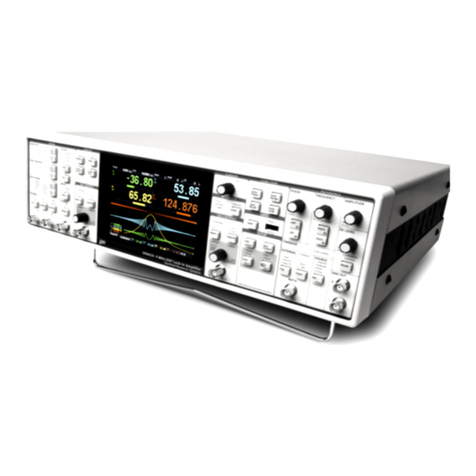
SRS Labs
SRS Labs SR865A User manual
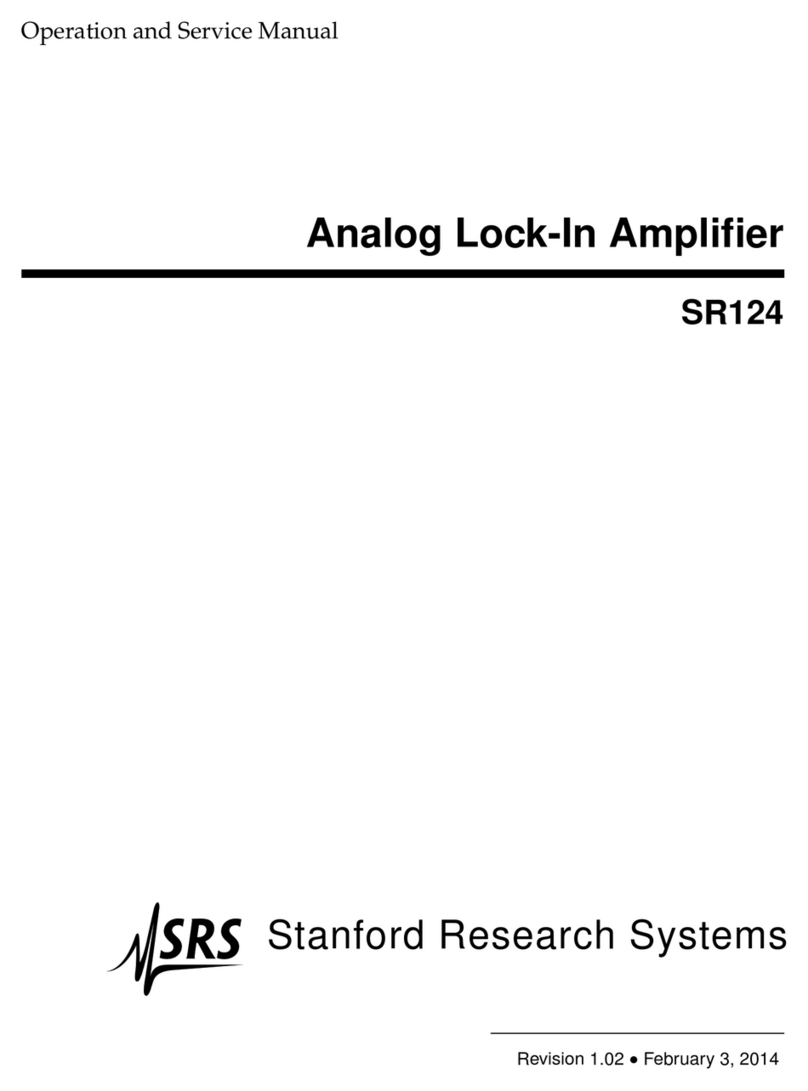
SRS Labs
SRS Labs SR124 User manual
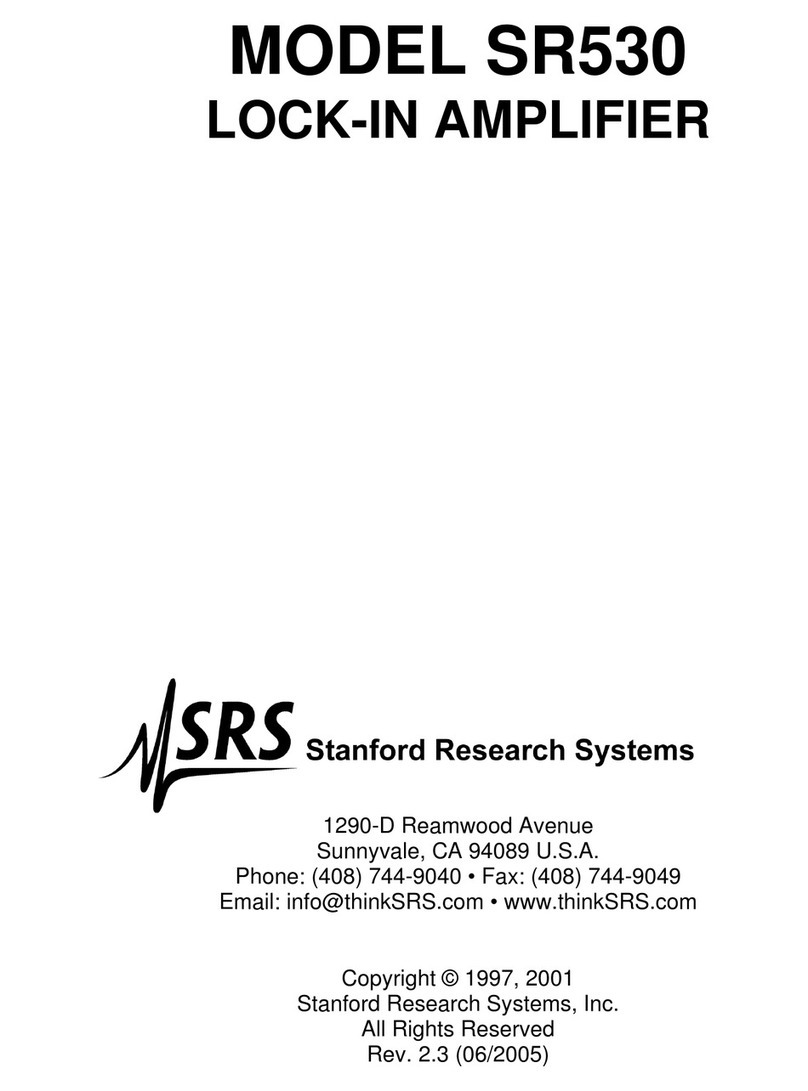
SRS Labs
SRS Labs SR530 Owner's manual
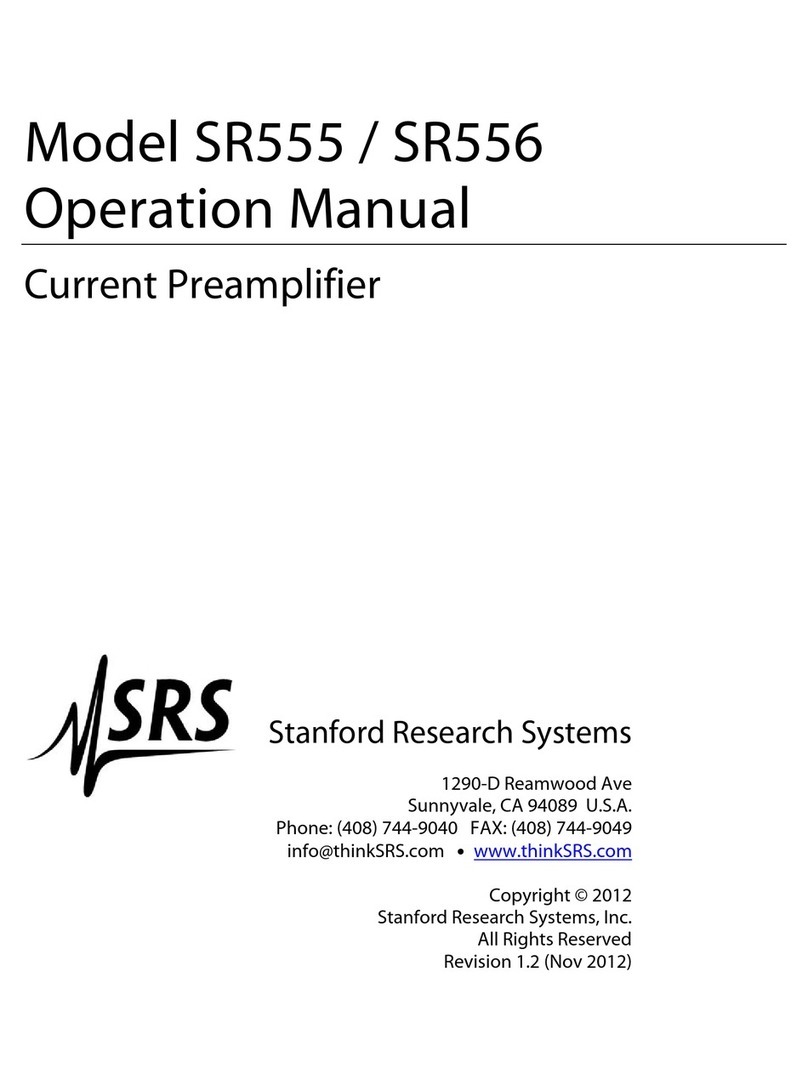
SRS Labs
SRS Labs SR555 User manual
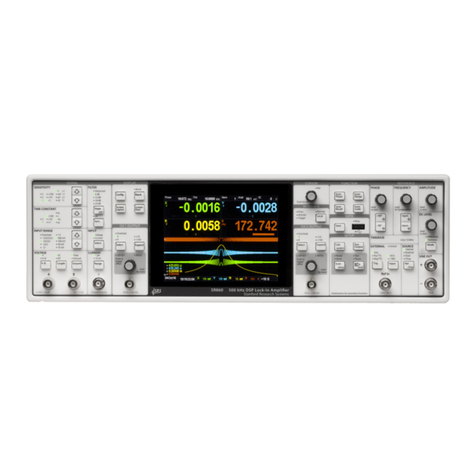
SRS Labs
SRS Labs SR860 User manual
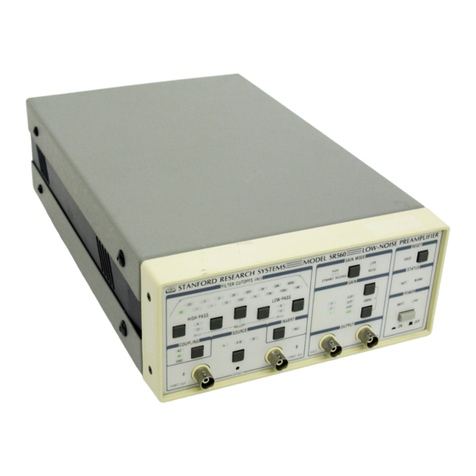
SRS Labs
SRS Labs SR560 Guide
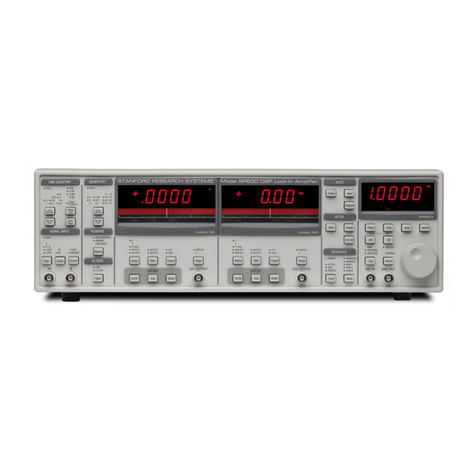
SRS Labs
SRS Labs SR830 User manual
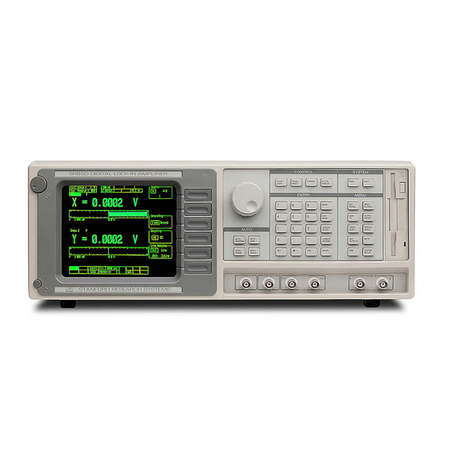
SRS Labs
SRS Labs SR850 User manual
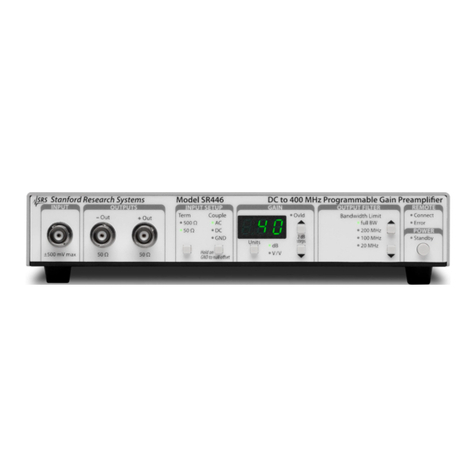
SRS Labs
SRS Labs SR446 User manual
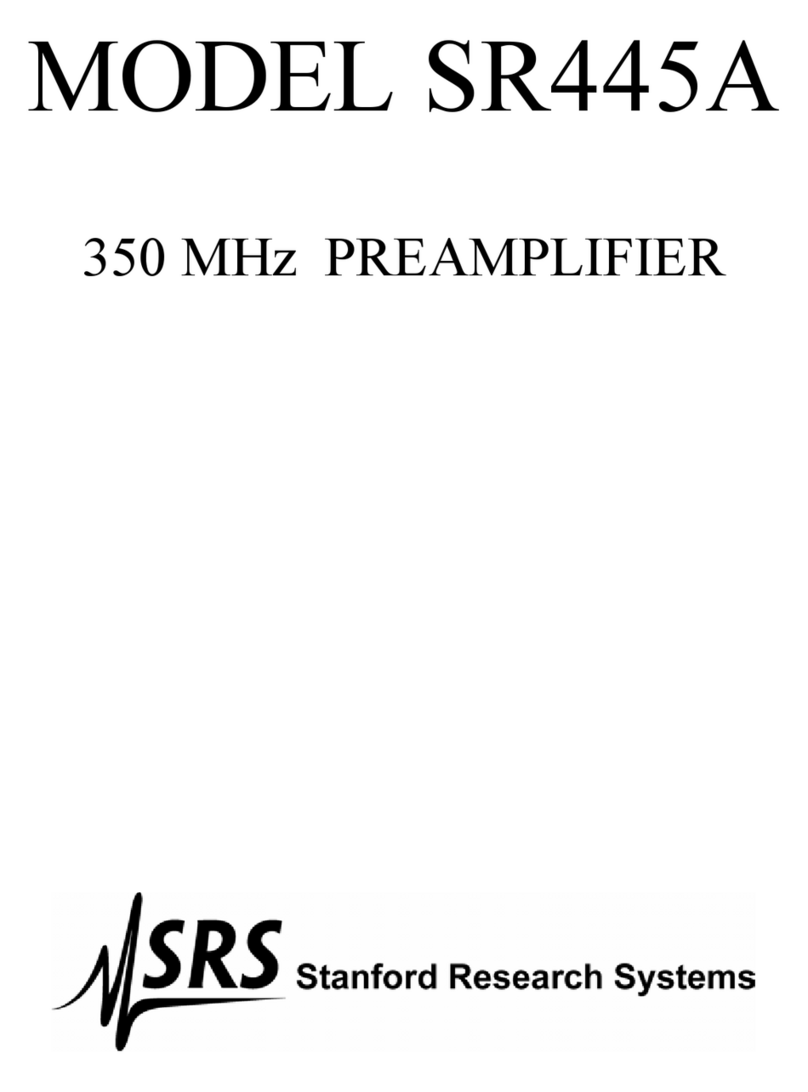
SRS Labs
SRS Labs SR445A User manual
Popular Amplifier manuals by other brands
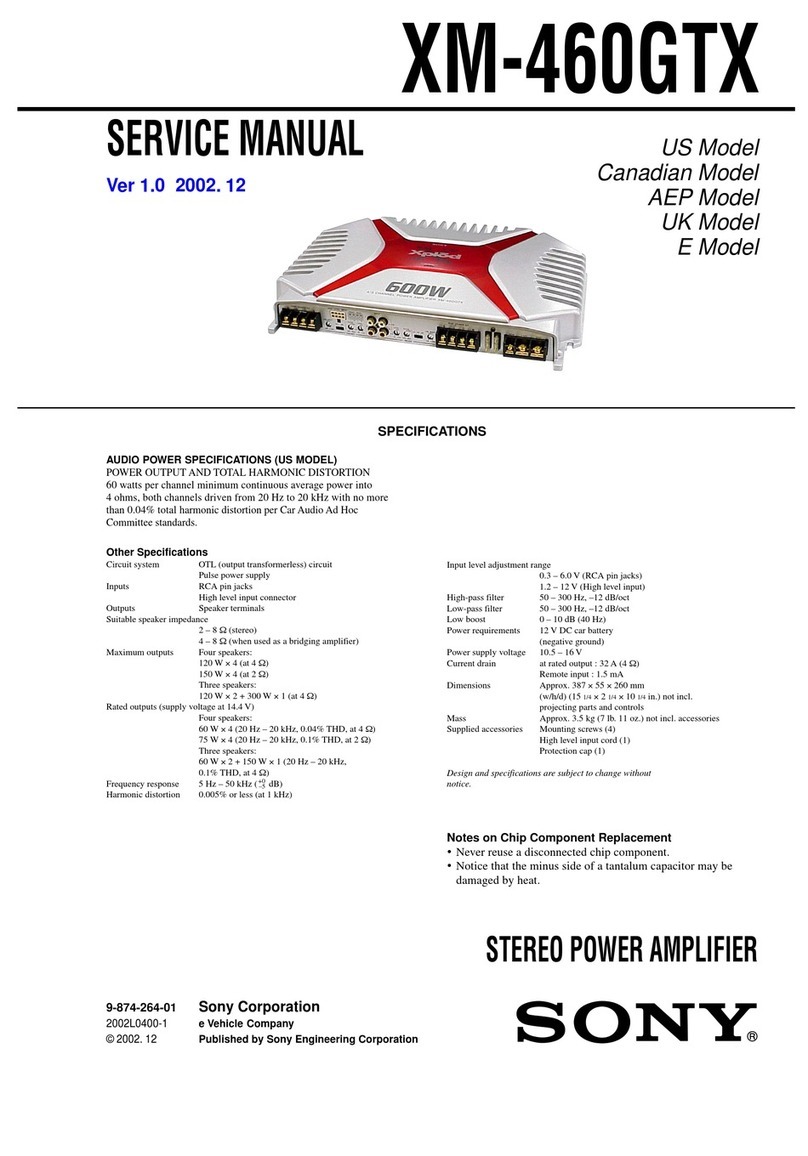
Sony
Sony XM-460GTX Marketing Specifications Service manual
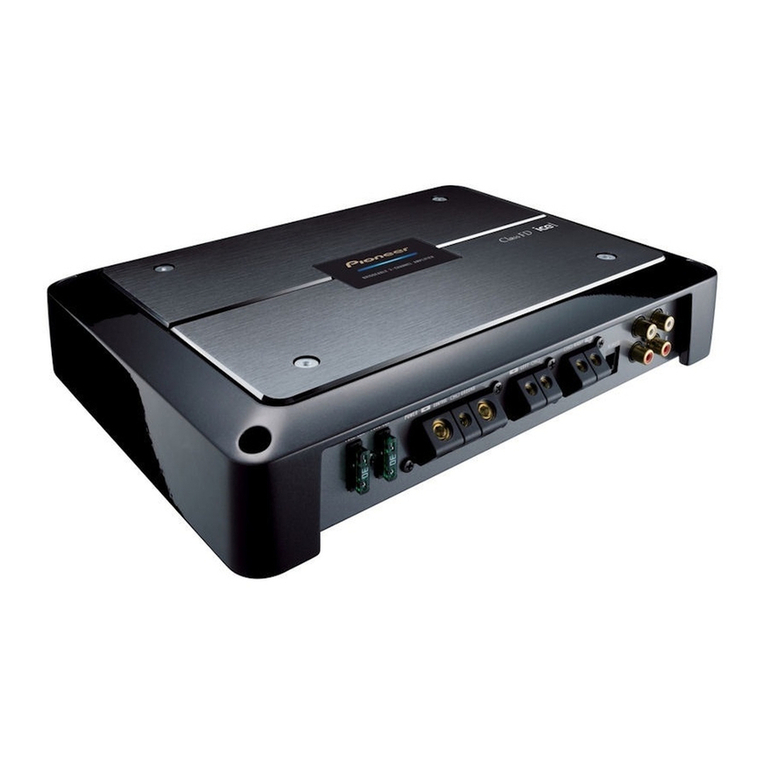
Pioneer
Pioneer PRS-D2200T - Premier Amplifier owner's manual
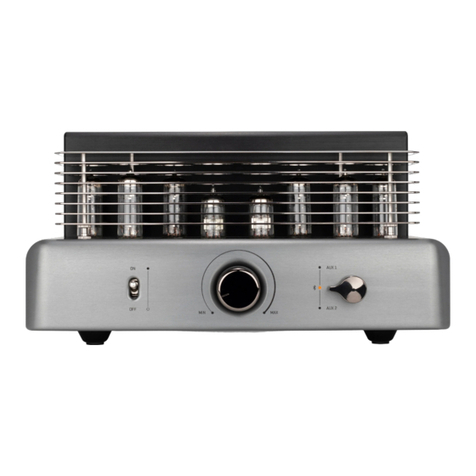
TRETTITRE
TRETTITRE TrePower1 user manual
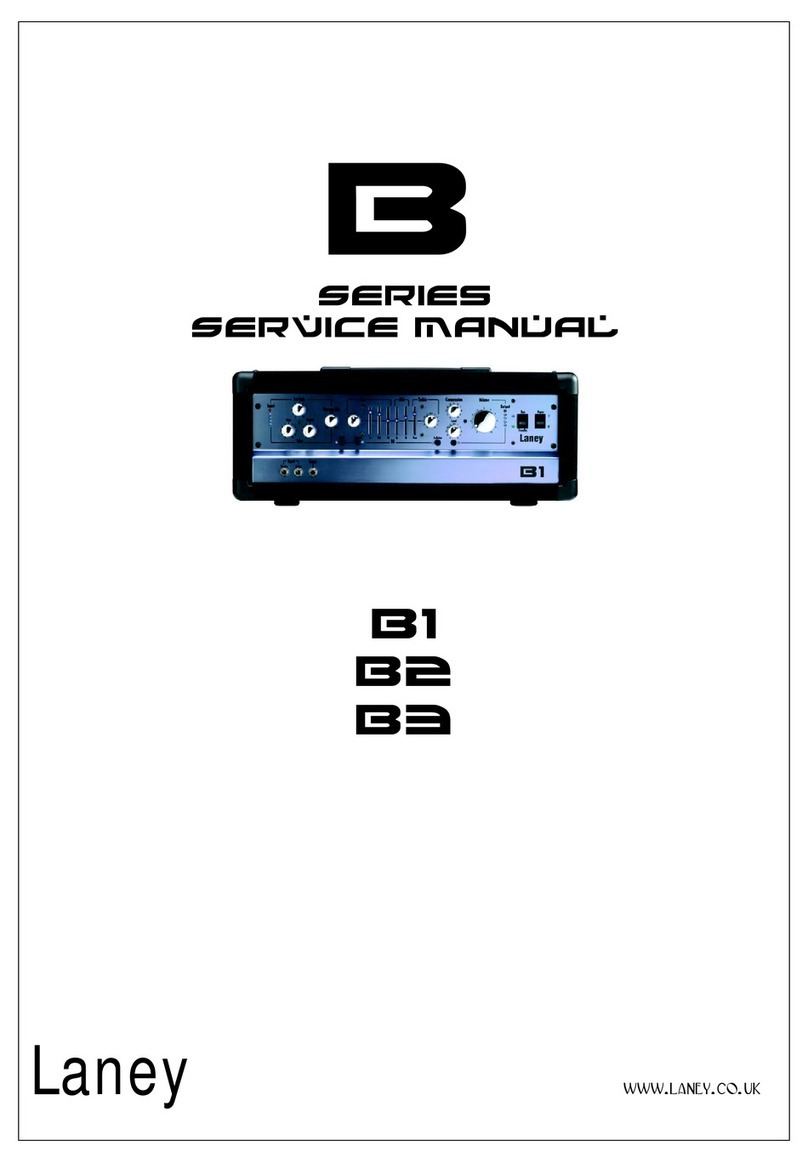
Laney
Laney B1 Service manual
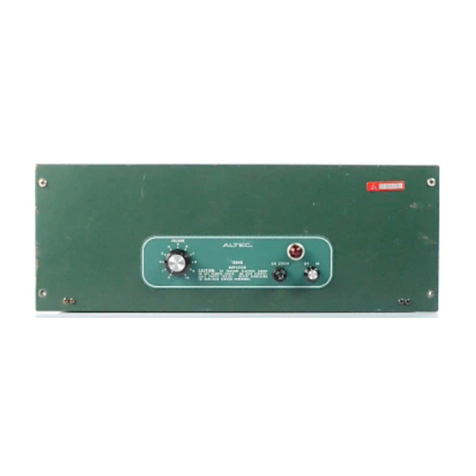
Altec
Altec 1594B operating instructions
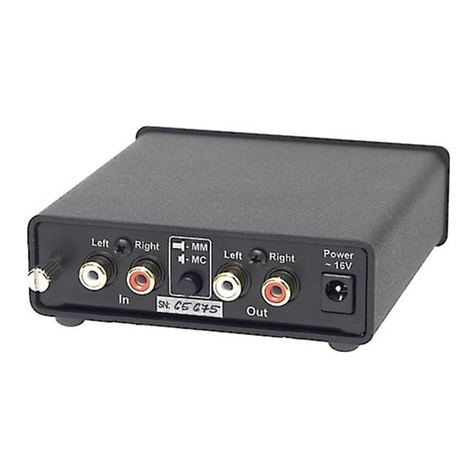
Pro-Ject Audio Systems
Pro-Ject Audio Systems Phono Box II USB Instructions for use
